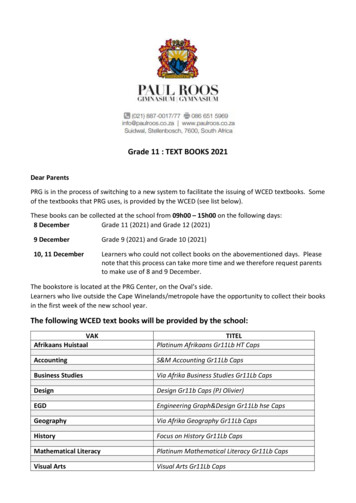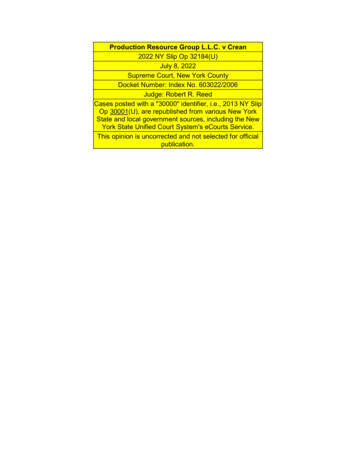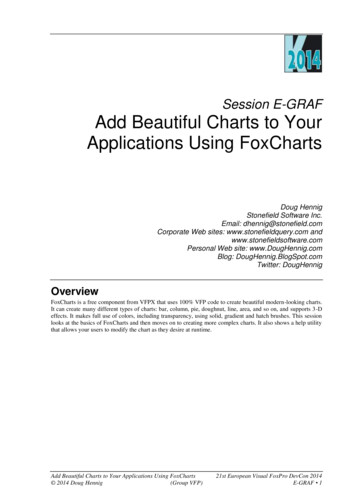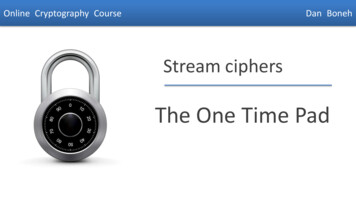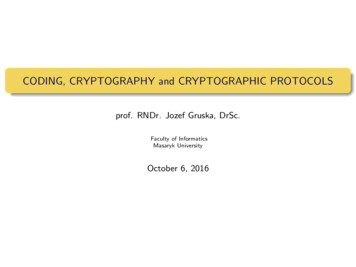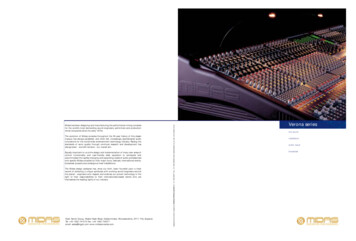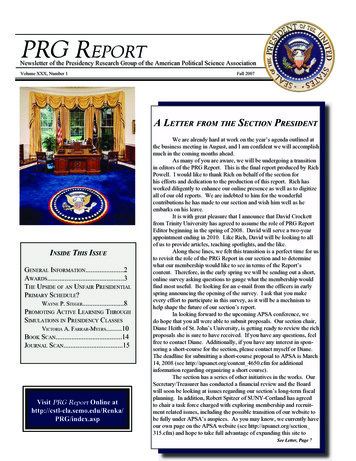
Transcription
PRG ReportNewsletter of the Presidency Research Group of the American Political Science AssociationVolume XXXI, Number 1Fall 2008From the EditorInside This IssueGeneral Information.2Awards. .3Announcements.7From the Archives.8PRG Survey Results.9The Duration of Policy AdoptedThrough Presidential ExecutiveOrdersGalen L. Steele.10The benefits of “Bunk”: Historyand the Pedagogy of the PresidencyGraham G. Dodds.13Using Popular Culture to Teachthe PresidencyJustin Vaughn.16Book Scan.18Journal Scan.20Visit PRG Report Online ome to another edition of the PRG Report. In addition tothe usual offerings we have some interesting items in this edition of theReport.First, and perhaps most important, is our annual list of PRGaward winners from the 2008 American Political Science Associationannual conference in Boston. One of the functions of the Report is toserve as a venue to honor our fellow colleagues for their hard work andexcellent scholarship. Congratulations for some well-deserved awards.If you are aware of other honors -- research or teaching -- from fellowpresidency scholars, please send the information my way.In an effort to document some of the activities of our group,our president has asked me to include in this edition of the Report a listof past officers, which you will find in the “From the Archives” feature.Following that is the Executive Summary of the survey the PRG administered to its members last year. As always, your humble editor is opento constructive comments about the Report. Please note especially thatcurrent and most past editions of the Report can be found on the PRGwebsite, listed in the box below left.We have three interesting articles in this edition. Galen Steelehas given us a peak at his dissertation work on executive orders, a subject of expanding research in recent years. Also, two participants in ourrecent Short Course, Graham Dodds and Justin Vaughn, share with ustheir thoughts on innovative teaching strategies, focusing on the use ofhistory and popular culture.Finally, you will find the book and journal article scans. Nomethodology is perfect when constructing these lists -- I am sure that Imiss articles in journals I do not think to check, and books that do nothit my search criteria on amazon.com. Please do not hesitate to forwardto me notifications of books you have had newly published or articles injournals that may escape my attention. My goal is to be as inclusive andcomprehensive as possible.I will conclude with my typical plea for you to consider thePRG Report as a possible outlet for your scholarship. With a historicelection and a new presidency beginning in 2009, there is bound to bea wealth of material for research. The Report is only as healthy as themembership that participates in its work. As always, the Report is available for articles concerning teaching and research and other professionally related items.My contact information is on page 2. I look forward to hearingfrom you.
PRG REPORTPRG OfficersPresidentCharles E. WalcottVirginia Polytechnic InstituteDepartment of Political Science528 Major Williams Hall - 0130Blacksburg, VA 24061cwalcott@vt.eduThe PRG Report is published twice annually on behalf of the PresidencyResearch Section of the American Political Science Association.The PRG Report serves the scholarly community in presidential and executivepolitics. The editor of the Report welcomes your submissions and ideas.Editor:David. A. CrockettDepartment of Political ScienceTrinity UniversityOne Trinity PlaceSan Antonio, TX 78212Phone: (210) 999-8344Fax: (210) 999-8320dcrocket@trinity.eduVice President & President ElectJeffrey E. CohenFordham UniversityDepartment of Political Science441 East Fordham RoadBronx, NY 10458cohen@fordham.eduSecretary/TreasurerMary StuckeyGeorgia State UniversityBox 4000Atlanta, GA 30302-4000joumes@langate.gsu.eduPRG Report EditorDavid A. CrockettTrinity UniversityDepartment of Political ScienceOne Trinity PlaceSan Antonio, TX 78212dcrocket@trinity.edu2009 Program ChairRandall E. AdkinsUniversity of Nebraska, OmahaDepartment of Political ScienceArts and Science Hall, Room 275 HOmaha, NE 68182radkins@unomaha.eduBoard of Directors:Lara Brown (2008-2011), Villanova UniversityRandall Adkins (2008-2011), University of Nebraska, OmahaNancy Baker (2006-2009), New Mexico State UniversityTerri Bimes (2006-2009), University of California, BerkeleyAndrew Dowdle (2008-2009), University of ArkansasMatthew Eshbaugh-Soha (2006-2009), University of North TexasLilly Goren (2007-2010), Carroll CollegeMartha Joynt Kumar (Ex Officio), Towson UniversityKen Mayer (2007-2010), University of WisconsinKevin McMahon (2007-2010), Trinity CollegeJeff Peake (2007-2010), Bowling Green State UniversityAndrew Rudalevige (2006-2009), Dickinson CollegeSteven Schier (2008-2011), Carleton CollegeWayne Steger (2008-2011), DePaul UniversityJustin Vaughn (2008-2011), Cleveland State UniversityJose Villalobos (graduate student, 2008-2011), Texas A&M UniversityShirley Anne Warshaw (2007-2010), Gettysburg CollegeStephen Weatherford (2008-2011), University of California, Santa BarbaraPast PresidentVictoria A. Farrar-MyersUniversity of Texas, ArlingtonDepartment of Political SciencePO Box 19539601 South NeddermanArlington, TX 76019-0539victoria@uta.eduFall 20082
AwardsPRG Section AwardsRichard E. Neustadt AwardThe Richard E. Neustadt Award is given for the best bookpublished that contributed to research and scholarship in the fieldof the American presidency during the previous year.2008 Richard E. Neustadt Award Co-recipients:Martha Joynt Kumar, Towson UniversityTitle: Managing the President’s Message (JohnsHopkins University Press)William G. Howell, University of ChicagoJon C. Pevehouse, University of ChicagoTitle: While Dangers Gather (Princeton UniversityPress)Nominations for the 2009 Neustadt Award can be sent to theaward committee. Nominations should be submitted by February1, 2009.David A. Yalof, ChairUniversity of ConnecticutDepartment of Political Science341 Mansfield Road, U-1024Storrs, CT 06269-1024david.yalof@uconn.eduCommittee Members:Terri Bimes, University of California, BerkeleyJohn Hart, Australian National UniversityRobert Shapiro, Columbia UniversityStephen Weatherford, University of California, Santa BarbaraFall 20083
Founders AwardThe Founders Award, named in honor of David Neveh, is givenfor the best paper presented by a graduate student at either thepreceding year’s APSA annual meeting or at any of the regionalmeetings in 2007-2008.2007-2008 Founders Award Co-recipients:Curtis W. Nichols and Adam Myers, The University of Texas atAustinTitle: “The Good, The Bad, and The Ugly: Exploitingthe Opportunity for Reconstructive Leadership”Nominations for the 2008-2009 Founders Award, named in honorof Francis Rourke, can be sent to the award committee.Brandon Rottinghaus, ChairUniversity of HoustsonDepartment of Political SciencePhillip Guthrie Hoffman Hall, Room 447Houston, TX 77204-3012bjrottinghaus@uh.eduCommittee Members:Alfred Cuzan, University of West FloridaGraham Dodds, Concordia UniversityBrendan Doherty, United States Naval AcademyAndrew Dowdle, University of ArkansasNominations should be submitted by May 1, 2009.Founders Award (PhD.)The Founders Award (PhD.), named in honor of Bert Rockman,is given for the best paper presented by a PhD-holding scholar atthe previous year’s APSA annual meeting.2008 Founders Paper Award Recipient:B. Dan Wood, Texas A&M UniversityTitle: “Presidential Saber Rattling and theEconomy”Nominations for the 2009 Founders Paper Award, named in honorof Lester Seligman, can be sent to the award committee.Daniel E. Ponder, ChairDrury UniversityDepartment of Political Science900 North Benton AvenueSpringfield, MO 65802deponder@drury.eduCommittee Members:Lara Brown, Villanova UniversityIrwin Morris, University of MarylandAndrew Rudalevige, Dickinson CollegeRaymond Tatalovich, Loyola University (Chicago)Nominations should be submitted by February 1, 2009.Fall 20084
Best UndergraduatePaper AwardThe Best Undergraduate Paper Award is given for the bestundergraduate paper completed in the present academic year.2007-2008 Best Undergraduate Paper Award Recipient:Brett Amelkin, Princeton UniversityTitle: “Fit to Print: Trends in New York TimesElection Coverage, 1960-2006”Nominations for the 2008-2009 Best Undergraduate Paper Awardcan be sent to the award committee.Matthew Eshbaugh-Soha, ChairUniversity of North TexasDepartment of Political ScienceWooten Hall 134Denton, TX 76203-5340mes@unt.eduCommittee Members:Ryan Barilleaux, Miami UniversityJean Garrison, University of WyomingTobias Gibson, Monmouth CollegeJustin Vaughn, Cleveland State UniversityNominations should be submitted by May 1, 2009.Paul Peck Presidential AwardThe Paul Peck Presidential Award is presented by the NationalPortrait Gallery of the Smithsonian Institution to honorpresidential service and portrayal. The PRG represents APSA asone of the eight nominating organizations. For more information,please visit http://www.npg.si.edu/.John T. Woolley, ChairUniversity of California, Santa BarbaraDepartment of Political ScienceMail Code 9420Santa Barbara, CA 93106-9420woolley@polsci.ucsb.eduCommittee Members:John Burke, University of VermontShirley Warshaw, Gettysburg CollegeThe deadline will be set by the Smithsonian Institution.Fall 20085
George C. Edwards IIIDissertation AwardThe George C. Edwards III Dissertation Award will be givenannually for the best dissertation in presidency researchcompleted and accepted during the previous calendar year.The recipient will receive a 200 award. To be considered forthe award, nominees must submit the following documents toeach member of the award committee: (1) a hard copy of thedissertation, (2) a PDF of the dissertation on a CD, (3) a nomineeform, and (4) a nominator form and letter. Forms are availableon the section’s web site. The award committee welcomesnominations by dissertation committee chairs or committeemembers.MaryAnne Borrelli, ChairConnecticut CollegeDepartment of GovernmentCollege Box 5418270 Mohegan AvenueNew London, CT 06320mabor@conncoll.eduCommittee Members:Stephen Borrelli, University of AlabamaMeena Bose, Hofstra UniversityRebecca Deen, University of Texas, ArlingtonJeffrey Peake, Bowling Green State UniversityNominations should be submitted by February 1, 2009.Career Service AwardThe Career Service Award is given every four years duringa presidential election year. The PRG shall form a committeeto give an award to recognize career service to the study of thePresidency.Bruce F. Nesmith, Coe College ChairCommittee Members:David Adler, Idaho State UniversityRyan Barilleaux, Miami UniversityMeena Bose, Hofstra UniversityElvin Lim, University of TulsaWinner: George C. Edwards III, Texas A&M UniversityFall 20086
AnnouncementsPresidential Studies Quarterly special editionon the 2008 presidential election“The 2008 Presidential Election,” Presidential StudiesQuarterlySpecial Issue Editor: Jeffrey Cohen, Department ofPolitical Science, Fordham UniversityFor the June 2010 issue, Presidential Studies Quarterly is planning a special issue on the 2008 presidential election. We alsoexpect the papers in this issue to be part of a larger volume on theelection. Although presidential elections happen only once everyfour years and thus are always noteworthy, the 2008 presidentialelection may be of historic consequence. For the special issue,the journal is open to articles on any aspect of the election, froma wide range of theoretical and methodological perspectives. Thejournal is especially interested in papers dealing with the role ofrace and gender, the impact of an unpopular sitting president, theimpact of fundamentals like the economy and campaign strategies, the use of new campaign technologies such as the internet,the role of money and campaign finance, the primary seasonand party nomination rules, changes in the electorate, as well aspapers that place the election into historical context and comparethe presidential and congressional elections, but we will considerother topics as well.NEW BOOK BY FRED GREENSTEINStudents of the presidency who are familiar with ThePresidential Difference: Leadership Style from FDR toGeorge W. Bush (2nd ed., Princeton University Press,2004) may be interested in knowing of the forthcomingfollow-up book, which applies the same analytic framework to the first seven chief executives. These men servedin a period when the broad description of the presidencyin the Constitution made it necessary for incumbents todefine the specifics of their responsibilities. It is entitledInventing the Job of President: Leadership Style fromGeorge Washington to Andrew Jackson. It will be published by Princeton University Press in the summer of2009. Examination copies will be available from the Pressin August at http://press.princeton.edu/class.html .We would like to receive a short abstract of the paper by July15, 2009. The deadline for paper submissions is September 1,2009. All manuscripts received by this deadline will be reviewed.Although we have no length limits, we prefer that papers not exceed 40 pages (including tables, figures, and references), doublespaced unless absolutely warranted. Additional submissionguidelines are available on the journal’s website at http://www.blackwellpublishing.com/journal.asp?ref 0360-4918.Presidential Studies Quarterly (PSQ) is the only scholarly journalthat focuses on the most powerful political figure in the world the president of the United States. An indispensable resource forunderstanding the U.S. presidency, Presidential Studies Quarterlyoffers articles, features, review essays, and book reviews covering all aspects of the American presidency. PSQ’s distinguishedcontributors are leading scholars and professionals in politicalscience, history, and communications.Questions about submissions should be directed to the specialeditor at cohen@fordham.edu.Fall 20087
From the ArchivesPast PRG OfficersYearPresident1980-1981Lester G. Seligman1981-1982Thomas Cronin1982-1983Stephen Wayne1983-1984Francis Rourke1984-1985George Edwards1985-1986John Kessel1986-1987Norman C. Thomas1987-1988Bert A. Rockman1988-1989Erwin C. Hargrove1989-1990Betty Glad1990-1991James Young1991-1993Samuel Kernell1993-1995Larry Berman1995-1997Martha J. Kumar1997-1999Terry Sullivan1999-2001Karen Hult2001-2003Robert Spitzer2003-2004Michael A. Genovese2004-2005Bruce Miroff2005-2006Nancy Kassop2006-2007Lori Cox Han2007-2008Victoria A. Farrar-MyersVice PresidentSecretary/TreasurerThomas CroninStephen WayneFrancis RourkeGeorge EdwardsJohn KesselNorman C. ThomasBert A. RockmanErwin C. HargroveBetty GladJames YoungSamuel KernellLarry BermanMartha J. KumarTerry SullivanKaren HultRobert J. SpitzerMichael A. GenoveseBruce MiroffNancy KassopLori Cox HanVictoria A. Farrar-MyersCharles E. WalcottMartha KumarMartha KumarMartha KumarMichael GrossmanMichael GrossmanMichael GrossmanMichael GrossmanMichael GrossmanMichael GrossmanMartha KumarMartha KumarMartha KumarTerry SulllivanKaren HultRobert J. SpitzerMichael A. GenoveseBruce MiroffNancy KassopLori Cox HanVictoria A. Farrar-MyersCharles E. WalcottJeffrey E. Cohencontinued from Page 9However, 16.2 percent responded by saying they had eithernever received the newsletter or had no knowledge of theReport’s existence. This theme continues into Question 16.When asked how might we improve the respondent’s experience with the PRG, 23 percent said that they did not knowthe PRG Report existed, had never received the newsletter, orhad no way to access it online. Also, 21 percent said that thewebsite has not been updated for nine months, could be betterformatted, does not provide a useful forum for research, andshould include alerts of new/upcoming events, publications,etc.RECOMMENDATIONS:***Seek alternative/additional ways to engage APSAmembers and increase the visibility of the PRGReport.Incorporate survey findings and suggestions regarding content into the PRG Report.Coordinate efforts regarding the PRG Report withother PRG initiatives related to communication withmember (e.g., website and listserv).Fall 20088
PRG Report SurveyExecutive SummaryIn the spring of 2008, the Presidency Research Group(PRG) introduced a new Editor of the PRG Report newsletter,and with his appointment decided to ascertain whether changes tothe design and information within the Report should be pursued in order to better serve and attract members. A survey wassent out to all current and lapsed members of the PRG utilizingcontact information obtained from APSA. The survey instrumentconsisted of 16 short questions and took between five to ten minutes to complete. The survey was distributed to 1,100 individuals,and 230 responded for a response rate of 21 percent. Below is adiscussion of the overall findings.Of the respondents, 78.7 percent were current membersand 21.3 percent were not current members of the PRG. Whenasked why they were a member of the PRG, 20.2 percent of therespondents said they were members for research purposes, 4.9percent said they were members for teaching purposes, and 71.0percent said they were members for both purposes. A majority ofrespondents were tenured or tenure-track professors at a four-yearuniversity or college (73.6 percent). The leading categories ofscholarly interest of the respondents were presidential-congressional research (13.7 percent), leadership (11.3 percent), historical presidency research (11 percent), and policy making (9.5percent).Questions 5 through 14 dealt primarily with the newsletter. When asked how often they view the PRG Report, respondents reported that they mainly view the Report only when eachissue is announced (60.5 percent). Nearly 18 percent almostnever view the newsletter, 15.4 percent have never viewed it,and 5.7 percent view it at least once a month. When asked whenthey read the Report, there was only a slight difference betweenrespondents reading the Report when it first comes out and whenthey have time (42.4 percent versus 36.4 percent, a 6 percentdifference). However, the fact that the newsletter is currentlyavailable only online made 44 percent of respondents less likelyto read it, although 41.3 percent said it had no effect at all.Question 7 asked participants to rank from one (representing their highest priority) to five (representing their lowestpriority) what they want to see in the Report. Some responses hadto be omitted due to non-answer. This question resulted in the following findings: 46.4 percent ranked a list of newly published/released presidency books as their highestpriority. 34.4 percent ranked a list of newly publishedjournal articles as their number one, while 27.3percent ranked it their number two, for a totalof 61.7 percent ranking this item number one ortwo. Only 22.8 percent of respondents rankedabstracts as their highest priority, with 28.7percent ranking it number three. Summary of research ranked number two ornumber three on almost half of the respondents’lists of priorities (23.6 percent and 25.1 percent,respectively). However, only 20 percent rankedit number one. 30.1 percent ranked short research notes theirsecond highest priority. Input on teaching was ranked the lowest priority by 26.5 percent of respondents, and 24.5percent ranked full length articles as their lowest priority.Overall, a list of newly published/released presidency books wasthe highest priority among respondents (46.4 percent), whileinput on teaching (26.5 percent) and full length articles (24.5percent) were the lowest priority among respondents.When asked what respondents would like to see inthe newsletter, 27.1 percent said they want to see summariesof books, recent journal articles, and recent conference papers,23.9 percent wanted announcements of conferences and callsfor papers, while an estimated 19.4 percent wanted to see bothoriginal research (e.g. articles, research notes) and articles and/or tips on teaching the presidency. Only 9.5 percent wanted to seeinformation on people in the news. Additionally, an overwhelming 82 percent said that each newsletter should offer articles andinformation on a range of different topics, compared to only 18percent who said that each issue should surround a specific themeof presidency research. When the issue of contributing to theReport was presented, 87.4 percent said that they would be willing to write an article or summary, and 80.1 percent said that theywould include a publication in the PRG Report in their vitae.Question 13 asked survey participants how relevantthe newsletter was to their decision in joining the PRG. Only4.5 percent said that it was their primary reason and 18 percentsaid it was very relevant. Conversely, 39.3 percent said it wasnot relevant at all, while 38.4 percent said that it was somewhatrelevant. When asked if a revised newsletter would better meettheir needs, thus becoming more relevant to their decision to be,or remain, a PRG member, only 25.4 strongly agreed, while 53percent somewhat agreed.Finally, Questions 15 and 16 allowed participants towrite in their own comments on what they would particularly liketo see included in the PRG Report and what could the PRG do toimprove their experience with the group overall. To better understand and classify the comments, they were grouped into categories by similar responses. When asked if there was anything inparticular that they would like to see included in the PRG Report,35.1 percent of respondents said that they would like to see shortresearch and teaching notes, preliminary research analyses, announcements of upcoming conferences, and calls for papers.Fall 2008continued previous page9
The Duration of Policy Adopted Through Presidential ExecutiveOrdersGalen L. SteeleOnly days after the 2008 presidential election, theObama transition team began reviewing hundreds of Bush executive orders to determine which orders to revoke. These ordersgarner such immediate attention because President Bush usedexecutive orders to adopt a number of significant policies overthe course of his eight years in the White House. His executiveorder policies include issues ranging from stem-cell research tooil and gas drilling, from the adoption of the faith-based initiative to domestic spying. The fact that President Bush was willingto adopt significant policy via executive order even though theseorders are easily revoked by any succeeding president revealsan apparent paradox in the nature of executive orders. Whyadopt significant policy using executive orders that are so easilyrevoked?If, as Moe and Howell (1999) suggest, a president’sprimary strategic motivation is to preserve his historical legacy,then executive orders are only effective to the degree that theycan survive long enough to assist in achieving that goal. On theone hand, the significance of the policy adopted through executive orders leads some scholars (Mayer 1999, 2001; Howell2003; Cooper 2002) to conclude that executive orders representa significant source of unilateral power which the president mayuse to establish a legacy. On the other hand, the susceptibilityof executive orders to revocation leads others to conclude thatexecutive orders are nothing more than very limited and temporary policy solutions (Light 1991; Schramm 1981), in which caseorders may not be helpful in creating a significant and enduringlegacy. While both arguments make assumptions about the duration of executive orders policy, the existing literature offers littlemore than speculation about the actual duration of policy adoptedby executive order. I extend existing understanding of executiveorders by demonstrating that a substantial proportion of executiveorders persist well beyond the tenure of the presidents that issuethem.Presently, the only consideration will be how long anexecutive order persists before being terminated, and whether apresident can reasonably expect policy adopted through executive orders to remain in effect following his departure from theWhite House.1 In pursuit of the answers to these questions, I willfirst examine the existing literature on executive order duration.Second, I will briefly explain the data used. Lastly I will providebasic answers regarding the expected duration of an executiveorder.Current ResearchDespite a rapidly growing body of literature on presidential executive orders, this research only speculates about theduration of policy adopted by executive order. Light (1991) and1For an examination of strategic considerations surrounding the termination of executive orders see Steele (2008).Schramm (1981) argue that executive orders offer only temporarypolicy solutions. Light states that executive orders “offer a verylimited and temporary alternative for policy initiatives” (1991,117). Cooper (2002) recognizes the potential for enduring policyimpact of executive orders (80), but also observes that hastilyissued orders are often immediately amended in order to correctbad policies (72). Finally, Warber (2006) suggests that presidentsmay not be concerned about the longevity of their orders because“presidents are more concerned about establishing their politicalcapital, than with focusing on the implementation and future fateof their directives” (55). Howell and Lewis (2002) offer the onlyempirical evidence regarding the duration of executive orders.They identify 43 administrative agencies created by executiveorder between 1945 and 1995 (2002). The agencies survived anaverage of 8.8 years (with a cut-off of 1997).DataSo that I may extend the examination of executive orderduration beyond the handful of cases used by Howell and Lewis(2002), this analysis takes into account all orders issued fromJanuary of 1959 to December of 1998. This range includes 2306orders issued from Dwight Eisenhower to Bill Clinton. The primary descriptive data for these orders is taken from the executiveorder disposition tables available from the National Archives.In order to determine the duration of an executive order,I determined both a date of origin and a date of termination. Every order’s date of origin is the date it was signed into law by thepresident. Dates of termination for these orders were determinedusing four separate examinations of the data. First, I coded datesof revocation provided by the National Archives in the Executive Order Disposition Table and the Codification of PresidentialProclamations and Executive Orders Disposition Tables. Second,I examined the text of the orders. If the text included a date oftermination or listed a specific time period that an order wouldbe in effect, I calculated the termination date based on the datesigned and the data provided in the text. If an order’s function isimmediately fulfilled, I coded the termination date the same asthe signed date. For example, if the only function of an order isto terminate another, the order is self-executing and no additionalaction is needed. Other examples are ceremonial orders, or orderssending employees home early on Christmas Eve. Third, if orderswere overturned by congressional legislation I used the datethe legislation was signed as the termination date for the order.Finally, if an order was revoked as a result of legal decision Iused the date of the court opinion as the date of termination. Datafor terminations by legislation or judicial review are providedfrom either Power without Persuasion (Howell 2003) or obtainedusing the same process employed by Howell. Congressional challenges were identified by using electronically searchable sourcessuch as Thomas Online, Congressional Informational Services,Fall 200810
and Congressional Alert. Howell identified all federal courtchallenges to executive orders from 1943-1998; I used Shepard’sCode of Federal Regulations Citations to identify any additionalcases from 1999 to 2004. The cut-off date for orders in this dataset is December of 1998; however, the survey of terminationdates extends to December of 2004. As a result the data mayunder-report the actual duration of later orders since the maximum age for an order issued in 1998 is 6 years.If an executive order is to help build a president’s historical legacy, it should both endure and also have some policysignificance. For example, Kennedy’s Peace Corps ExecutiveOrder 10924 not only sent a message about his approach to foreign policy, but it also created an agency that continues to operatetoday. While most orders alter administrative policy in someway, there are also many trivial orders like Carter’s ExecutiveOrder 12126 which corrected a typographical error in an earlierorder. To verify that there is not a difference in duration betweensignificant executive orders and the general body of executiveorders I rely on a sample of significant executive orders identifiedby Mayer and Price (1999). Using a random sampling of executive orders Mayer and Price (1999) identify 149 significant ordersissued between 1938 and 1998. Mayer and Price did not identifyall significant orders during this time frame, but from this samplethey concluded that presidents do rely on executive orders to effect significant policy change and to signal other strategic actors.I coded the 86 of these orders issued between 1959 and 1998 assignificant, and determined their termination dates using the sameprocess as all other orders.Executive Order DurationAt first glance, executive orders appear to be easy targetsconsidering that they can be easily revoked by any succeeding president. They can also be issued with built-in terminationdates, or they can just be carried out and completed. Despite the
Galen Steele has given us a peak at his dissertation work on executive orders, a sub- . San Antonio, TX 78212 dcrocket@trinity.edu 2009 Program Chair Randall E. Adkins University of Nebraska, Omaha . (2007-2010), Gettysburg College Stephen Weatherford (2008-2011), University of California, Santa Barbara PRG RePoRt

